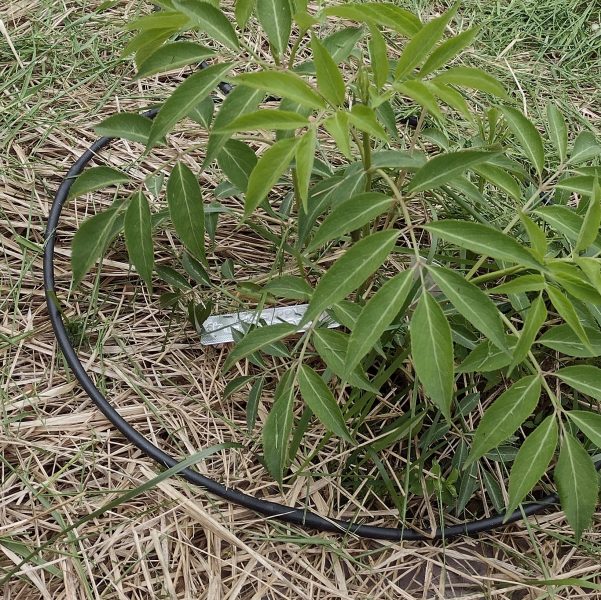
The potatoes are in the ground. Hopefully they really take off. The garlic looks great.











The potatoes are in the ground. Hopefully they really take off. The garlic looks great.











We planted the 3rd pecan tree, spread pine straw and took some time to enjoy the pleasure of flying a kite in the back field. What a nice day. Warm and sunny.









Since we started the farm, one of the things I’m looked forward to is planting blueberries. We had a couple of delays putting them in, but now they are finally installed.


My wife Connie, came up with a wonderful idea. She suggested that we plant blueberries in the Hugelkultur mound. This gives the blueberries a wonderfully sunny place that is very well drained. The hugelkultur mound is approximately 85 feet long x 30 feet wide. It is now home to 20 blueberry plans (all rabbiteye), raspberries and goji berries. This area has easy access to drip irrigation and is inside the anti-deer fence. We planted a mixture of blueberries, including Columbus, IRA, Yadkin and Tifblue varieties. The raspberries are Fall Gold from Rabbit Ridge Nursery in Coates, NC. The raspberries are acclimated to this area, so we hope they will do well. We still need to put up the trellis for the raspberries and the goji berries.

We are excited to have bees on the property. We have partnered with a local beekeeper so we can offer honey from our farm later in the year. I’ll post a blog entry when the honey is available. The bees will also help pollinate our berries and crops.
We also plan to bees on your place in the mountains again this summer (www.troublesomegap.com) so we should have sourwood honey available as well.
The flowers are coming up on the farm, so spring isn’t that far away.






There are lots of great crops to grow in the winter. The best part is that there is much less weeding in the winter!










It was relaxing putting lime on the back field and getting it mowed. It is ready for winter. Nice to be able to take a break from a very busy summer growing season.

Checkout the winter garden










Thanks to the families that have made this year’s community garden a success!













Everything is growing! Here are some images from this week.






























Lets take a walk around the farm and see what is growing!
One of the topics that comes up in the video is the concept of imposing my will on the farm. Planning for the growing season requires creating a calendar of when to do what. Different crops need to go in at different times so that requires planning. We need to have the ground ready to plant. This year is very much a building year so we had infrastructure that had to go in. We put in:
We have also been working to add additional perennials this year
The garden beds are shaping up. They spent the last three months under a silage tarp but are now mostly ready to plant. The elderberries, figs and peaches are growing.
We also did work in the food forest area that we started building in 2021. We added a trellis for the blackberries and covered the hugelkultur mound with a silage tarp for 3 months to help suppress weed growth this summer. We also put down a biodegradeable paper around the bushes and trees and covered it with hay.
These have been great successes. Which would not be possible without everyone that has helped out on the farm. Our farm is structured as a communal community farm. We have another family that helps out. We share the harvest with them. Having their help has made this possible.
One of the challenges of accomplishing these things is timing. It is critical to have materials (hay, biodegradeable paper, plants, hardware and lines for the drip irrigation, and a bunch of various item) in place and ready to install. The next step is to have a plan where the materials and manpower are ready to go. I developed a calendar for the year. Then each week we have a list of items to accomplish. The list makes helps everyone to plan their time and know what tools to bring. It also helps us to work as a group and sometimes to break down in to 2 groups to work on some items in parallel.
Weather is always a factor with outdoor activities like hiking or camping. Weather is an even bigger factor with farming. Not only the weather on the day you plan to work in the fields but also the weather leading up to the days you have planned to work.
If the fields are wet, then you may have to wait for them to dry out before preparing beds or planting. If the soil isn’t warm enough then seeds won’t germinate. A late frost can kill young plants. Maybe the tractor breaks down in the middle of the field (been there).
It takes effort and organization to
Days and weeks before you
So you have all this lined up and on the calendar. But that doesn’t mean it will happen. Weather, equipment issues, or other frustrations can keep your plans from happening.
My desire and my decision to do X,Y, and Z on a certain day doesn’t mean it will happen. My will to accomplish work on the farm is totally subservient to reality of circumstance. There are many things that can delay plans or even cancel them. Its really easy to assume that because I planned something and got everything ready, then it will happen. The life lesson comes when it doesn’t . Farming will teach that life lesson again and again. I’m not able to impose my will on the farm. It works better if I set up goals and plan for success but not get upset if those plans don’t work out. Humility wins. Farming, or even gardening, will definitely teach you humility, patience and the value of a backup plan / rain date.
Parting words: plant a garden!

Our food forest is starting to grow with the warmer weather. Here are some pictures
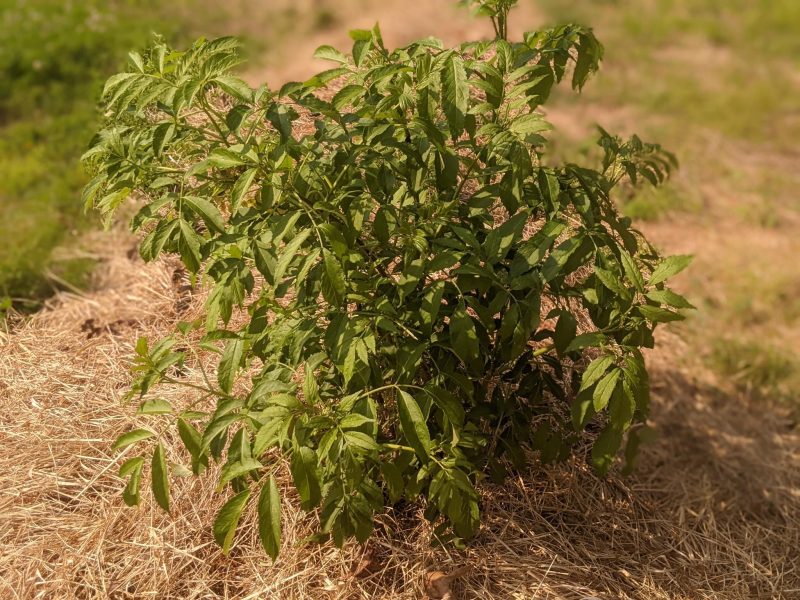
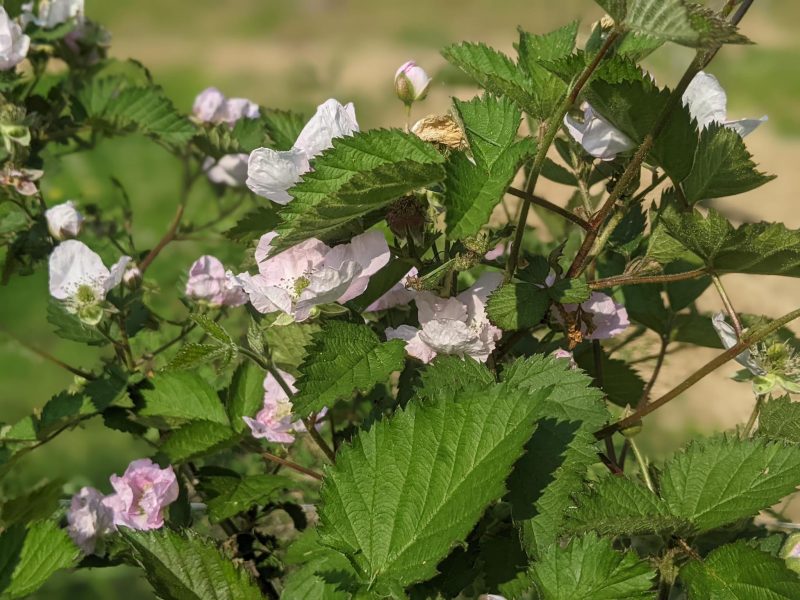


The last two days have been a blur. We have been busy. Even with 4 people on the farm working hard, we still have more stuff to do before everything is been planted.
We are on still on a rapid learning curve as we work hard. The garden area in the pictures below was pasture for decades so we had to work to plow up the grassy area and then build new beds.
The BCS tiller was also a new piece of equipment for us. The biggest challenge we’ve had with the BCS is laying out beds so that the rows come out the width that we want. Our BCS tractor has the 5.5 inch extensions added to the the 749 tractor. This makes the tractor wider by 11 inches.
The vegetable garden beds are on a sloped face. To help minimize any erosion issues during rain events, we kept a 10 foot ribbon of grass between each plot. Each plot was laid out to have 2 rows per plot (30″ wide rows) with an 18″ wide walkway between each row. When I added up 3 walkways plus a quantity of 2 of the 30″ wide rows, then we should need a plot that is 9.5 feet wide. In practice, it just isn’t working out that way. I suspect we’ll have to till and hill a plot and measure to see where I’m off in my estimation of the total width of each 2 row plot. There is definitely a learning curve to becoming a better farmer.
We just installed rows of trellis for pole beans and tromboncino squash. We are using a curved trellis for the tromboncino squash and pole beans. I keep seeing videos and picture of the curved and over trellis configuration, so we wanted to see at try and find out if it works as well as we keep hearing. The curved trellis (when covered with tromboncino squash) should provide provide shade for the young rhubarb.
One of my projects for this summer is to install posts in the field, near the rows, where we can hang the cattle panels (used in the trellis) this fall after we take the trellis down and store it for the winter.
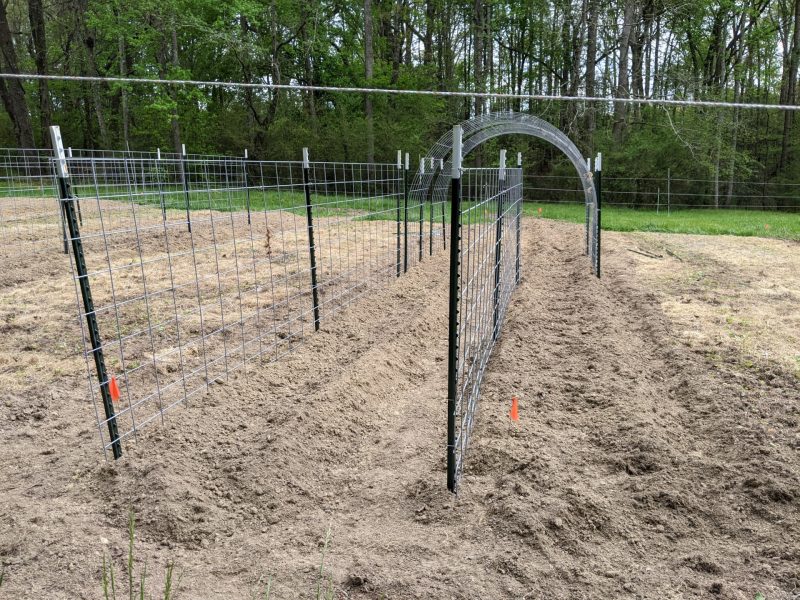
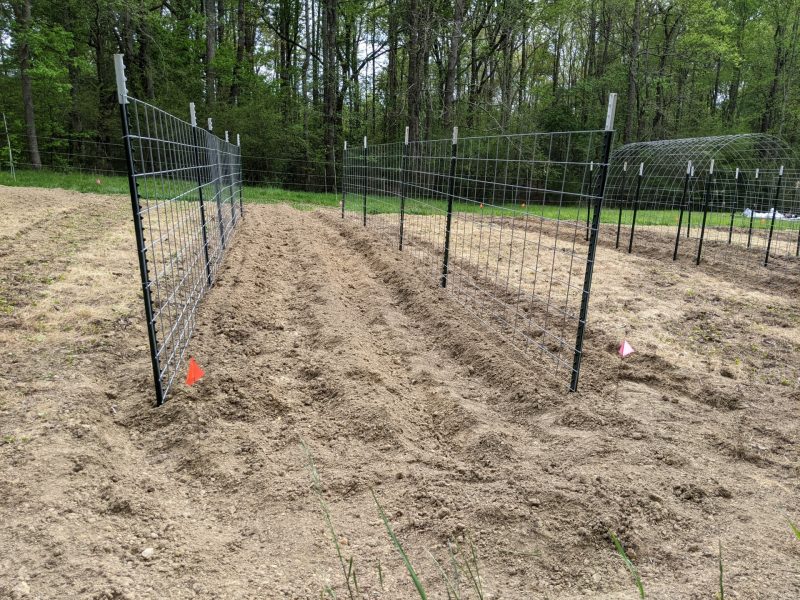
One of the projects this month was to map and tag each fruit bearing tree and bush. My wife took this project and ran with it. We now have a map that shows the location of each fruit bearing tree and bush, indicated by a unique tag number. The unique tags number are recorded in a spreadsheet. Information about each plant is recoded with the tag number, such as variety and date planted. This will also us to track historical data about each plant. This data is also useful when we propagate cuttings, allowing us to properly identify plants for sale.
